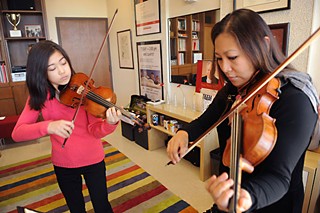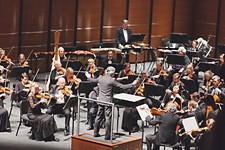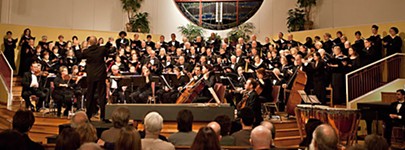World on a String
Young violinists from across the globe flock to Austin for North America's first Menuhin Competition
By Robert Faires, Fri., Feb. 21, 2014
The heavy wooden door may muffle human voices, but the voice of a violin sings right through it, so that anyone passing the office/studio of violinist Sandy Yamamoto on this Saturday in February could hear one sweetly but methodically working its way through Henryk Wieniawski's brisk and bracing Etude-Caprice No. 5. A phrase is played, then played again and perhaps again before moving on to the next. Much of the repetition has the mechanical quality of pursuing a technique and its mastery, but every so often a spark strikes, and one can hear the kindling of artistry within that technical proficiency.
Given the skill of the playing and resolve of the player, as well as the fact that we're inside a music building on the University of Texas campus, you'd be forgiven for supposing the musician playing to be of college age or older. But no, the violinist so hard at work is actually 12, a sixth-grader at Spring Creek Academy in Plano, Texas. Claire Wells is paying one of her weekly visits to Austin to work with Yamamoto in preparation for the Menuhin Competition, a contest for violinists under the age of 22. Every two years, young players from around the globe vie for the competition's top prizes: cash awards of up to $10,000 and the loan of a vintage Italian violin for a year, not to mention the honor of a win, place, or show in one of the classical world's most prestigious tourneys. This year's – the 16th – is being hosted by the Butler School of Music.
Needless to say, the students facing off in the Menuhin aren't your typical teen instrumentalists, dabbling in classical until some other interest – astronomy, track, dating – grabs their attention. These are committed players, often with more years of musical training than time in school. Claire, who first stuck a violin under her chin at age 3, has been a winner in a number of competitions (Hubbard Concerto Competition, Vernell Gregg Young Artists Competition, Dallas Symphonic Festival, Oregon Junior Bach Festival), played with chamber orchestras in Kansas and Germany, and soloed with several symphony orchestras, most recently the Jalisco Philharmonic Orchestra in Guadalajara, Mexico. Her peers are similarly accomplished. There's Ludvig Gudim, 15, who performed in a televised concert for the Norwegian king and queen's 75th birthday celebration and earned a special prize at Germany's Louis Spohr Competition. And Ania Filochowska, 20, won first prize in the Queens Symphony Orchestra's Young Soloist Competition and has played in Italy, Austria, Canada, the Czech Republic, and her native Poland, where she was given an award for artistic achievement from the Ministry of Culture and National Heritage.
If this calls to mind those jaw-droppingly skilled gymnasts scoring gold medals before they can drive, you're on the mark. This "Olympics of the violin," as it's been called, demands that its teen competitors perform a 35-minute recital of works that would trip up many an adult violinist. The Junior level in which Claire will be competing – the Menuhin is split between Juniors (violinists under age 16) and Seniors (violinists ages 16-21) – requires the participating musicians to play one of three Fantasias for Solo Violin by Telemann, one of Wieniawski's Etudes-Caprices (he wrote eight), either a Mozart Adagio or a Beethoven Romance, a new work by UT professor of composition Dan Welcher, commissioned especially for the 2014 competition ("The Cowboy and the Rattlesnake"), and a three-minute improvisation on an American folk song. But that's just the first round. Should Claire advance to the finals, she'll need to play the first movement of a sonata by Schubert, Brahms, or Beethoven (her choice); Halvorsen's Passacaglia in G Minor for Violin and Cello (to be performed with UT professor of cello Bion Tsang); and her choice of a composition by Sarasate, Saint-Saëns, Waxman, or Wieniawski, to be performed with the UT Symphony Orchestra.
Requirements for the Seniors are equally daunting. Round One: one of three solo sonatas by J.S. Bach; the second movement from one of five Mozart violin concertos; one of the 24 Caprices for solo violin by Paganini; and a piece by Fritz Kreisler. Semi-Finals: two movements from one of three works by Haydn, to be performed with the Miró Quartet (!), a new work by UT professor of composition Donald Grantham ("Black-Eyed Suzy"), and a piece of the competitor's choice, 12 minutes or less. Finals: a full concerto by either Mendelssohn, Barber, Prokofiev, or Saint-Saëns, to be played with the Austin Symphony Orchestra. Whew!
The fate of the competitors lies with nine jurors who have extensive experience in the classical field. For the 2014 Menuhin, that includes internationally renowned musicians and educators, former winners, and Butler School of Music faculty members such as violinist Brian Lewis and professor of piano Anton Nel. Given the different nationalities and musical personalities, they may well appreciate different qualities in a competitor. That presents a challenge for Yamamoto in helping prepare Claire for the competition. Having a juror's scoring sheet and experience herself jurying for national competitions give her a reasonable idea of what jurors look and listen for (an idea she'll share publicly in "The Juror's Ear," a program with Menuhin Competition Artistic Director Gordon Back on Tuesday, Feb. 25), but even then, it's a question as to how to anticipate those nine varying tastes.
Ultimately, for Yamamoto as a teacher, it comes down to letting Claire be Claire. "I want to make sure that her voice is heard," she says. Yamamoto recalls first hearing that voice last summer in Ottawa, Kan., where she was on the faculty of BLYAP – the Brian Lewis Young Artist Program, a camp run by her Butler School colleague in which a dozen violinists 18 or younger get two weeks of intensive training each year. "Claire stuck out to me because – first of all, she's so young. You hear a lot of talented 12-year-olds who have a lot of facility, but the thing that struck me was Claire's beautiful tone. She had a very natural way of approaching music [and] a very vocal way of playing, which was very interesting to me."
So when Claire and her parents, John and Cheryl – both skilled violinists themselves – learned that the first Menuhin Competition ever held in North America would be taking place in their backyard (as Texans measure distance, anyway) and decided to audition, they had a strong ally in Yamamoto. Even before the Competition, competition was fierce. A record number of entrants (275, up from an average of 170) made Claire's acceptance into the Menuhin an achievement in itself. But once the Wells family received word in November that Claire was one of the 42 competitors, the race was on to get ready: choosing her selections and honing them, getting some coaching at home – "Dad and Mom come and tell me stuff, and I shoo them away," Claire teases – and making those all-important weekly drives to Austin.
On this visit – the last before the Menuhin Competition begins on Feb. 21 – John, Cheryl, and Cheryl's sister, who has traveled from China to hear her niece compete, sit quietly while Claire takes pass after pass at the Wieniawski. In front of posters and photos from Yamamoto's 15 years as a member of the world-class Miró Quartet – a possible career path for Claire one day, perhaps? – Yamamoto listens closely, interjecting a suggestion here, a word of encouragement there. Claire considers this one of the most challenging pieces – "It's really fast and very technical" – but she glides through it with a confidence and poise beyond her years. The tone that caught Yamamoto's ear is evident whenever she puts bow to strings.
Yamamoto says that she's making sure each piece has a different style: "I want a different sound for her Beethoven Romance, and the Telemann – totally different kind of work. And Wieniawski – you're hopping from country to country and century to century, and I want her performance to be like a journey for the audience. That's my biggest goal for her, besides just enjoying it and having fun. Because she's done all the hard work. Now the most she can do is just go and enjoy and share with the audience what she feels in the music at that point."
For more information about the 2014 Menuhin Competition, including the full program of events, visit www.menuhincompetition.org.













